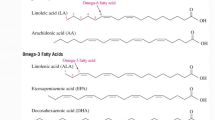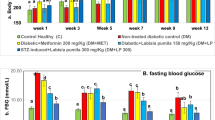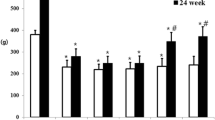Summary
Essential fatty acid metabolism is impaired by diabetes mellitus and γ-linolenic acid rich treatments such as evening primrose oil correct deficits in nerve conduction and endoneurial blood flow in diabetic rats. Other mechanistically unrelated treatments, such as antioxidants and aldose reductase inhibitors have a similar effect and there may be positive interactions with multiple treatments. Our aim was to compare the efficacy of a novel essential fatty acid derivative, ascorbyl γ-linolenic acid, with that of γ-linolenic acid in correcting diabetic neurovascular deficits. Eight weeks of diabetes caused 20.4 and 48.2% reductions in sciatic motor conduction velocity and nutritive endoneurial blood flow, respectively. Treatment was given for the last 2 weeks with γ-linolenic acid (100 mg · kg−1 · day−1) either in pure form or as ascorbyl γ-linolenic acid, an equivalent dose of ascorbate (21 mg · kg−1 · day−1) or jointly with ascorbate and γ-linolenic acid. Conduction velocity was corrected by 39.8, 87.4, 13.2 and 66.8% with γ-linolenic acid, ascorbyl γ-linolenic acid, ascorbate and γ-linolenic acid plus ascorbate, respectively. Corresponding ameliorations of the nutritive blood flow deficit were 44.0, 87.4, 13.2 and 65.7%. For the γ-linolenic acid plus ascorbate combination, and especially for ascorbyl γ-linolenic acid, the magnitude of correction for conduction velocity and blood flow was greater than expected for simple addition of ascorbate and γ-linolenic acid, indicating a synergistic interaction. Thus, with an efficacy 40 times that of evening primrose oil in rats, ascorbyl γ-linolenic acid may be a suitable candidate for clinical trials of diabetic neuropathy.
Similar content being viewed by others
Abbreviations
- ARI:
-
Aldose reductase inhibitor
- GLA:
-
γ-linolenic acid
- NCV:
-
nerve conduction velocity
- NO:
-
nitric oxide
- ROS:
-
reactive oxygen species
- PG:
-
prostaglandin
References
Gregerson G (1967) Diabetic neuropathy: influence of age, sex, metabolic control and duration of diabetes on motor conduction velocity. Neurology 17: 972–980
Gregersen G (1968) A study of peripheral nerves in diabetic subjects during ischaemia. J Neurol Neurosurg Psychiatry 31: 175–181
Eliasson SG (1964) Nerve conduction changes in experimental diabetes. J Clin Invest 43: 2352–2358
Seneviratne KN, Peiris OA (1969) The effects of hypoxia on the excitability of isolated peripheral nerves of alloxan-diabetic rats. J Neurol Neurosurg Psychiatry 32: 462–469
Low PA, Lagerlund TD, McManis PG (1989) Nerve blood flow and oxygen delivery in normal, diabetic and ischemic neuropathy. Int Rev Neurobiol 31: 355–438
Cameron NE, Cotter MA (1994) The relationship of vascular changes to metabolic factors in diabetes mellitus and their role in the development of peripheral nerve complications. Diabetes Metab Rev 10: 189–224
Tesfaye S, Malik R, Ward JD (1994) Vascular factors in diabetic neuropathy. Diabetologia 37: 847–854
Julu POO (1988) Essential fatty acids prevent slowed nerve conduction velocity in streptozotocin diabetic rats. J Diabet Complications 2: 185–188
Cameron NE, Cotter MA, Robertson S (1991) Effects of essential fatty acid dietary supplementation on peripheral nerve and skeletal muscle function and capillarisation in streptozotocin diabetic rats. Diabetes 40: 532–539
Dines KC, Cotter MA, Cameron NE (1993) Contrasting effects of treatment with Ω-3 and Ω-6 essential fatty acids on peripheral nerve function and capillarization in streptozotocin-diabetic rats. Diabetologia 36: 1132–1138
Ward KK, Low PA, Schmelzer JD, Zochodne DW (1989) Prostacyclin and noradrenaline in peripheral nerve of chronic experimental diabetes in rats. Brain 112: 197–208
Dines KC, Cotter MA, Cameron NE (1995) Comparison of the effects of evening primrose oil and triglycerides containing γ-linolenic acid on nerve conduction and blood flow in diabetic rats. J Pharmacol Exp Ther 273: 49–55
Stevens EJ, Carrington AL, Tomlinson DR (1993) Prostacyclin release in experimental diabetes: effects of evening primrose oil. Prostaglandins Leukot Essent Fatty Acids 49: 699–706
Cameron NE, Cotter MA (1994) Effects of evening primrose oil treatment on sciatic nerve blood flow and endoneurial oxygen tension in streptozotocin-diabetic rats. Acta Diabetologica 31: 220–225
Keen H, Payan J, Allawi J et al. (1993) Treatment of diabetic neuropathy with γ-linolenic acid. Diabetes Care 16: 8–15
Cameron NE, Cotter MA, Dines KC, Maxfield EK, Carey F, Mirrlees DJ (1994) Aldose reductase inhibition, nerve perfusion, oxygenation and function in streptozotocin-diabetic rats: dose-response considerations and independence from a myo-inositol mechanism. Diabetologia 37: 651–663
Calcutt NA, Mizisin AP, Kalichman MW (1994) Aldose reductase inhibition, Doppler flux and conduction in diabetic rat nerve. Eur J Pharmacol 251: 27–33
Hotta N, Kaskuta H, Fukasawa H et al. (1995) Effect of a potent new aldose reductase inhibitor (5-(3-thienyl)tetrazol-1-yl)acetic acid (TAT), on diabetic neuropathy in rats. Diabetes Res Clin Pract 27: 107–117
Cameron NE, Cotter MA, Archibald V, Dines KC, Maxfield EK (1994) Anti-oxidant and pro-oxidant effects on nerve conduction velocity, endoneurial blood flow and oxygen tension in non-diabetic and streptozotocin-diabetic rats. Diabetologia 37: 449–459
Nagamatsu M, Nickander KK, Schmelzer JD et al. (1995) Lipoic acid improves nerve blood flow, reduces oxidative stress and improves distal nerve conduction in experimental diabetic neuropathy. Diabetes Care 18: 1160–1167
Cotter MA, Love A, Watt MJ, Cameron NE, Dines KC (1995) Effects of natural free radical scavengers on peripheral nerve and neurovascular function in diabetic rats. Diabetologia 38: 1285–1294
Cameron NE, Cotter MA (1995) Neurovascular dysfunction in diabetic rats: potential contribution of autoxidation and free radicals examined using transition metal chelating agents. J Clin Invest 96: 1159–1163
Cameron NE, Cotter MA (1992) Impaired contraction and relaxation in aorta from streptozotocin-diabetic rats: role of polyol pathway activity. Diabetologia 35: 1011–1019
Cameron NE, Cotter MA, Dines KC, Maxfield EK (1993) Pharmacological manipulation of vascular endothelium function in non-diabetic and streptozotocin-diabetic rats: effects on nerve conduction, hypoxic resistance and endoneurial capillarization. Diabetologia 36: 516–522
Cameron NE, Cotter MA, Hohman TC (1996) Interactions between essential fatty acid, prostanoid, polyol pathway and nitric oxide mechanisms in the neurovascular deficit of diabetic rats. Diabetologia 39: 172–182
Cameron NE, Cotter MA, Harrison J (1986) The effects of diabetes on motor nerve conduction velocity in different branches of the rat sciatic nerve. Exp Neurol 92: 757–761
Greene DA, De Jesus PV Jr, Winegrad AI (1975) Effects of insulin and dietary myo-inositol on impaired peripheral motor nerve conduction velocity in acute streptozotocin diabetes. J Clin Invest 55: 1326–1336
Cameron NE, Cotter MA, Robertson S (1989) The effect of aldose reductase inhibition on the pattern of nerve conduction deficits in diabetic rats. Q J Exp Physiol 74: 917–926
Cameron NE, Leonard MB, Ross IS, Whiting P (1986) The effects of Sorbinil on peripheral nerve conduction velocity, polyol concentrations and morphology in the streptozotocin diabetic rat. Diabetologia 29: 168–174
Sharma AK, Bajada S, Thomas PK (1981) Influence of streptozotocin-induced diabetes on myelinated nerve fibre maturation and integrity and on body growth in the rat. Acta Neuropathol 53: 257–265
Thomas PK, Jefferys JGR, Sharma AK, Bajada S (1981) Nerve conduction velocity in experimental diabetes in the rat and rabbit. J Neurol Neurosurg Psychiatry 44: 233–238
Wright RA, Nukuda H (1994) Vascular and metabolic factors in the pathogenesis of experimental diabetic neuropathy in mature rats. Brain 117: 1395–1407
Malone JI, Lowitt S, Korthals JK, Salem A, Miranda C (1996) The effect of hyperglycemia on nerve conduction and structure is age dependent. Diabetes 45: 209–215
Young IS, Torney JJ, Trimble ER (1992) The effect of ascorbate supplementation on oxidative stress in the streptozotocin diabetic rat. Free Rad Biol Med 13: 41–46
Hunt JV, Bottoms MA, Mitchinson MJ (1992) Ascorbic acid oxidation: a potential cause of the elevated severity of atherosclerosis in diabetes mellitus? FEBS Letts 311: 161–164
McLennan S, Yue DK, Fisher E et al. (1988) Deficiency of ascorbic acid in experimental diabetes. Relationship with collagen and polyol pathway abnormalities. Diabetes 37: 359–361
Cunningham JJ, Mearkle PL, Brown G (1994) Vitamin C: an aldose reductase inhibitor that normalizes erythrocyte sorbitol in insulin-dependent diabetes mellitus. J Am Coll Nut 13: 344–350
Keegan A, Walbank H, Cotter MA, Cameron NE (1995) Chronic vitamin E treatment prevents defective endothelium-dependent relaxation in diabetic rat aorta. Diabetologia 38: 1475–1478
Rösen P, Ballhausen T, Bloch W, Addicks K (1995) Endothelial relaxation is disturbed by oxidative stress in the diabetic rat heart: influence of tocopherol as antioxidant. Diabetologia 38: 1157–1168
Otter DJ, Chess-Williams R (1994) The effects of aldose reductase inhibition with ponalrestat on changes in vascular function in streptozotocin diabetic rats. Br J Pharmacol 113: 576–580
Manku MS, Oka M, Horrobin DF (1979) Differential regulation of the formation of prostaglandins and related substances from arachidonic acid and from dihomogammalinolenic acid. II. Effects of vitamin C. Prostaglandins Med 3: 129–137
Yasuda H, Sonobe M, Yamashita M et al. (1989) Effect of prostaglandin E1 analogue TFC 612 on diabetic neuropathy in streptozocin-induced diabetic rats comparison with aldose reductase inhibitor ONO 2235. Diabetes 38: 832–838
Lands WEM (1992) Biochemistry and physiology of n-3 fatty acids. FASEB J 6: 2530–2536
Kihara M, Nickander KK, Low PA (1991) The effect of aging on endoneurial blood flow, hyperemic response and oxygen-free radicals in rat sciatic nerve. Brain Res 562: 1–5
Cameron NE, Cotter MA, Low PA (1991) Nerve blood flow in early experimental diabetes in rats: relation to conduction deficits. Am J Physiol 261:E1-E8
Cornblath DR, Brown MJ (1988) Influence of malnutrition on developing rat peripheral nerves. Exp Neurol 99: 403–411
Cameron NE, Cotter MA (1995) Comparison of the effects of chronic aldose reductase inhibitor and acetyl-l-cysteine treatments on peripheral nerve blood flow and function in anaesthetized diabetic rats. J Physiol 483P:142P-143P (Abstract)
Dyck PJ, Karnes JL, O'Brien P, Okazaki H, Lais A, Englestad J (1986) The spatial distribution of fiber loss in diabetic polyneuropathy suggests ischemia. Ann Neurol 19: 440–449
Llewlyn JG, Thomas PK, Gilbey SG, Watkins PJ, Muddle JR (1988) Pattern of myelinated fibre loss in the sural nerve in neuropathy related to type 1 (insulin-dependent) diabetes. Diabetologia 31: 162–167
Yagihashi S (1995) Pathology and pathogenetic mechanisms of diabetic neuropathy. Diabetes Metab Rev 11: 193–225
Tesfaye S, Harris N, Jakubowski JJ et al. (1993) Impaired blood flow and arterio-venous shunting in human diabetic neuropathy: a novel technique of nerve photography and fluorescein angiography. Diabetologia 36: 1266–1274
Newrick PG, Wilson AJ, Jakubowski J, Boulton AJM, Ward JD (1986) Sural nerve oxygen tension in diabetes. BMJ 293: 1053–1054
Vinik AI, Newlon PG, Lauterio TJ et al. (1995) Nerve survival and regeneration in diabetes. Diabetes Rev 3: 139–157
Reja A, Tesfaye S, Harris ND, Ward JD (1995) Is ACE inhibition with lisinopril helpful in diabetic neuropathy? Diabet Med 12: 307–309
Maxfield EK, Love A, Cotter MA, Cameron NE (1995) Nerve function and regeneration in diabetic rats: effects of ZD-7155, an AT1 receptor antagonist. Am J Physiol 269:E530-E537
Shupek M, Ward KK, Schmelzer JD, Low PA (1989) Comparison of nerve regeneration in vascularized and conventional grafts: nerve electrophysiology, norepinephrine, prostacyclin, malondialdehyde, and the blood-nerve barrier. Brain Res 493: 255–230
Apfel SC, Arezzo JC, Brownlee M, Federoff H, Kessler JA (1994) Nerve growth factor administration protects against experimental diabetic sensory neuropathy. Brain Res 634: 7–12
Ekstrom AR, Kanje M, Skottner A (1989) Nerve regeneration and serum levels of insulin-like growth factor-I in rats with streptozotocin-induced insulin deficiency. Brain Res 496: 141–147
Hellweg R, Hartung HD (1990) Endogenous levels of nerve growth factor (NGF) are altered in experimental diabetes mellitus: a possible role for NGF in the pathogenesis of diabetic neuropathy. J Neurosci Res 26: 258–267
Calcutt NA, Muir D, Powell HC, Mizisin AP (1992) Reduced ciliary neuronotrophic factor-like activity in nerves from diabetic or galactose-fed rats. Brain Res 575: 320–324
Author information
Authors and Affiliations
Rights and permissions
About this article
Cite this article
Cameron, N.E., Cotter, M.A. Comparison of the effects of ascorbyl γ-linolenic acid and γ-linolenic acid in the correction of neurovascular deficits in diabetic rats. Diabetologia 39, 1047–1054 (1996). https://doi.org/10.1007/BF00400653
Received:
Revised:
Issue Date:
DOI: https://doi.org/10.1007/BF00400653




